#pre-incan culture
Explore tagged Tumblr posts
Photo
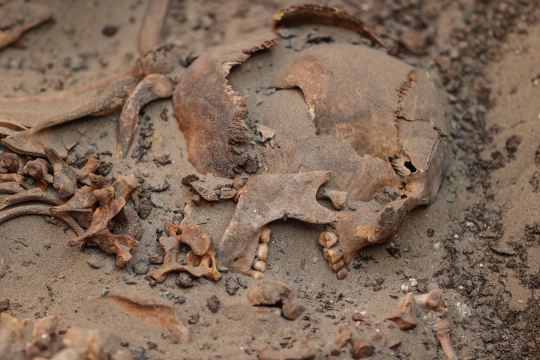
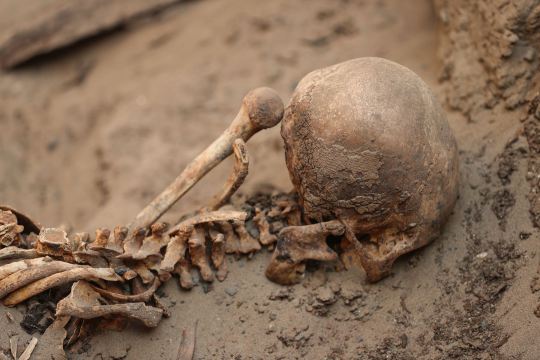
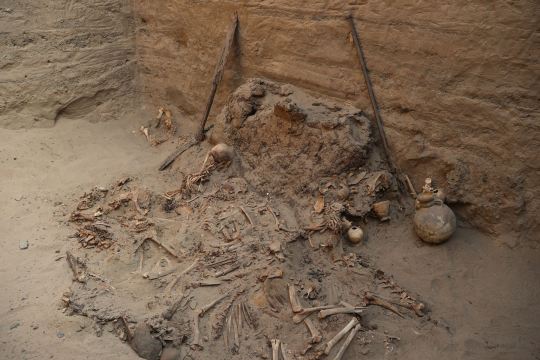
Sea Lord’s 1,000-Year-Old Tomb Uncovered in Peru
Hidden under the tan-brown dirt of Peru, a sea lord’s skeleton rested among the luxuries of the afterlife. Surrounded by sacrifices and offerings, the elite figure was forgotten — until now.
Archaeologists excavating the Macatón cemetery in Huaral uncovered the large tomb, the National Major University of San Marcos said in a May 15 news release.
The 1,000-year-old tomb was about 23 feet deep and about 23 feet wide, the release said. Inside, archaeologists found an elite figure, as well as five other people, four llamas and several pottery vessels.
The burial was left by the Chancay culture, a pre-Incan culture that developed between 1000 and 1500 A.D., the release said.
The tomb’s central elite figure was identified as a sea lord, the excavation’s lead archaeologist Pieter Van Dalen Luna told EFE. The presence of a wooden oar — the first artifact of its kind found at the Macatón cemetery — led to this identification, the outlet reported.
The sea lord was likely dedicated to fishing, shellfish hunting or another marine activity, Van Dalen said.
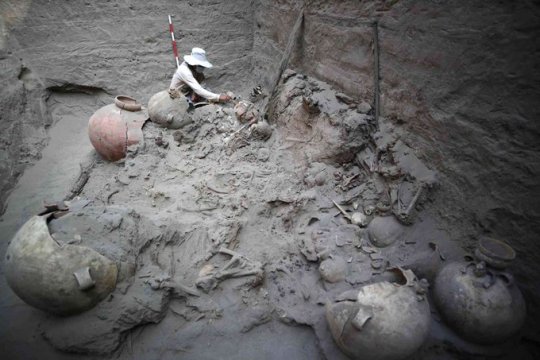
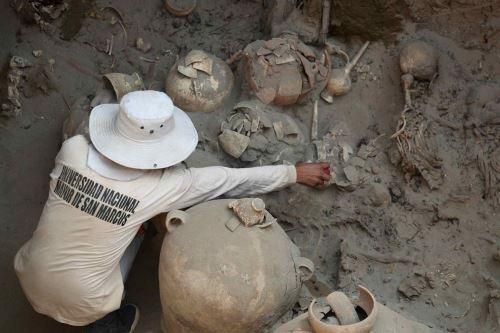
The burial also contained 25 pottery vessels with offerings of food for the deceased’s afterlife, EFE reported.
The Chancay culture believed deceased individuals did not cease to exist but became protective ancestors through a series of transformative stages on their path to the dead, experts said in the release.
The Chancay culture faded around 1500 A.D. at a time coinciding with the Incan empire’s territorial expansion, EFE reported.
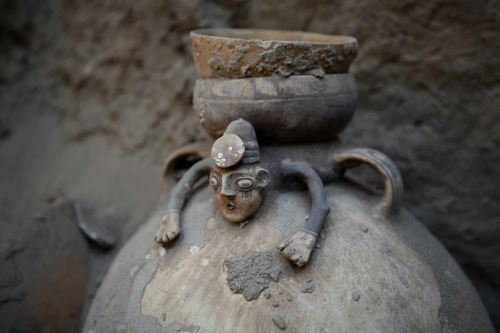

The excavation site is about 165 feet from a neighborhood of homes, BBC reported. These houses are likely preventing archaeologists from uncovering other tombs, but the houses also deterred looters from disturbing the area, archaeologists told the outlet.
The sea lord’s tomb is the oldest and largest tomb of about 80 burials found in the Macatón cemetery so far, BBC reported.
Archaeologists will continue analyzing the remains of the deceased to further understand the burial, the release said.
Haural is about 45 miles northwest of Lima.
By Aspen Pflughoeft.
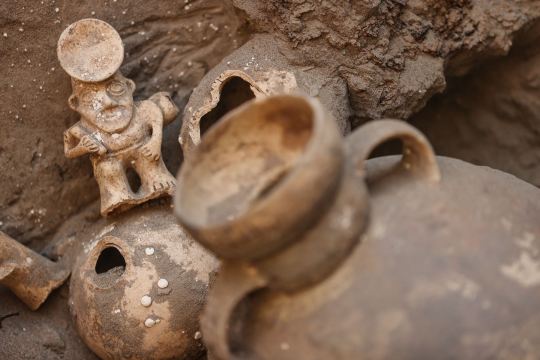
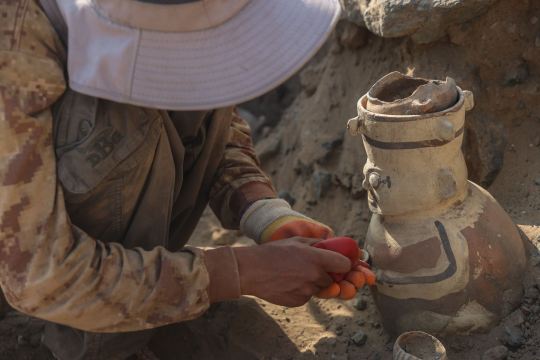

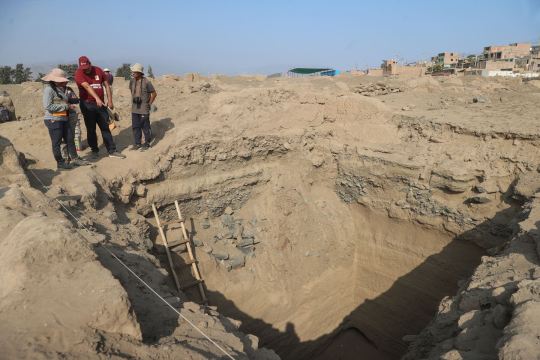
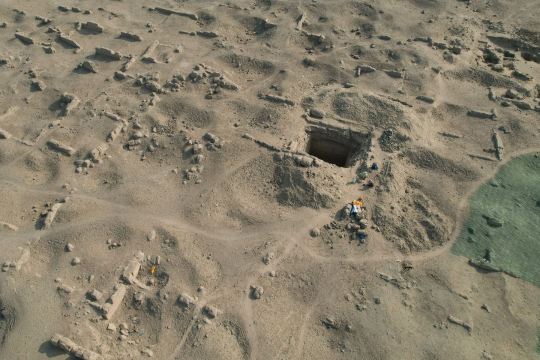
#Sea Lord’s 1000-Year-Old Tomb Uncovered in Peru#Macatón cemetery#chancay culture#pre-incan culture#ancient tomb#ancient grave#skeleton#pottery#ancient artifacts#archeology#archeolgst#history#history news#ancient history#ancient culture#ancient civilizations#long reads
64 notes
·
View notes
Text
Inca Maiden
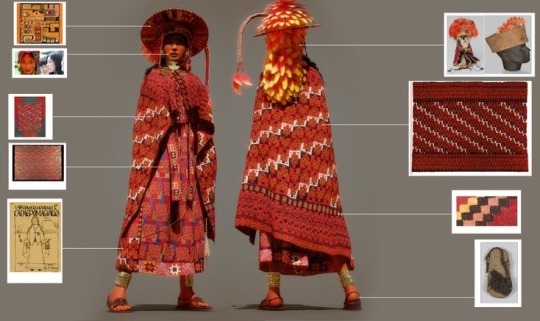
The clothes shown here correspond to the Chuquibamba style, an allied kingdom of the Inca empire
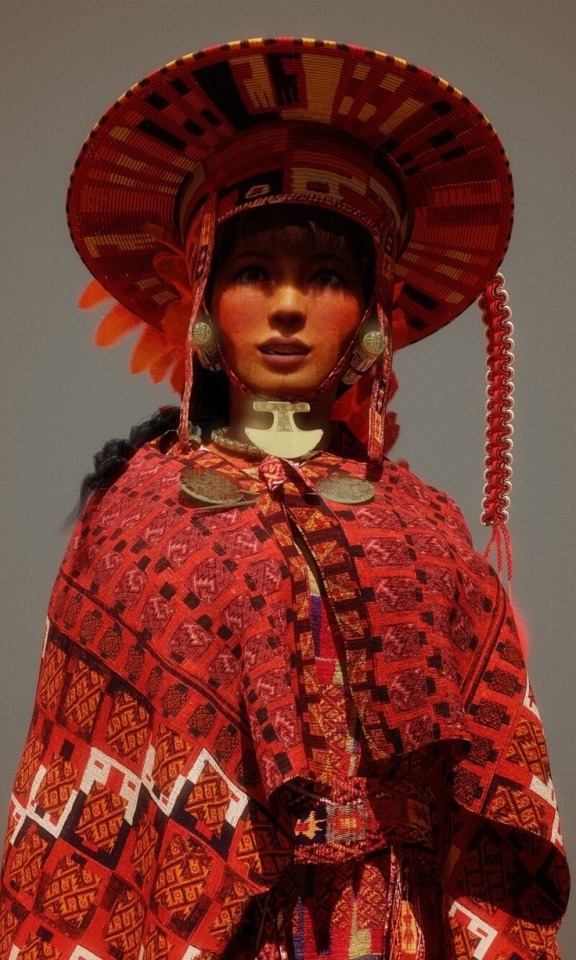
The acllas in the Tahuantinsuyu*, were the women of greater cultural preparation. These women were recruited and then chosen to be prepared in the so-called Acllahuasis, which were in charge of the Mamaconas, as stated by the chronicler Bernabé Cobo:
"... the acllahuasi or house of chosen women was an institution that brought together the Mamaconas or Ladies Mothers who acted as teachers and a credible number of girls entering a closing regime between the ages of ten and twelve. They were collected as a tribute among the most noble and beautiful ... "
Source
*Empire of four (the Inca empire)
#incan#inca#inca culture#incas#Inca Maiden#Maiden#Acclahuasi#Mamacona#tahuantinsuyu#Chuquibamba#incan art#pre columbian#peru#inca empire#ladie mothers#ancient history#ancient america#priestess#royality#noble woman#aclla#acllas
20 notes
·
View notes
Note
Are the Urswali-Dain people/the dainlands apart of Imperial Wardin?
No, Imperial Wardin is relatively small (though in-universe is pretty damn big. Most societies are small scale, singular state-entities that control this much territory are an outlier.). It is Interactive with some of the Dain-speaking populations on the other side of the Viper (and has some wholly unrealized expansionist designs against them), but no territorial control whatsoever. (Also there's been a lot of revision since they were last brought up, Urswali do not speak a Dain language family tongue).

A lot of fictional pre-modern empires are modeled after The Big Ones with massive territorial claims (or to be real, Rome specifically rather than other Big Ones like the Mongol or Incan empires) so I think that a lot of people have that in the back of their minds but like. Nah it's a relatively small space of land (my current estimate is like..... about the size of contemporary Spain?? give or take?????). The models I've referenced for designing its structure and logistics are geographically smaller states (I would consider the Aztec, Mali, and Maybe the Athenian (via Delian League) states to be decent analogues in very different ways, though none are actually like. Close analogues.).
It's composed of eight provinces all deferential to the Usoma ruling out of the Wardin province- a core alliance between two former kingdoms and a city-state (Wardin, Ephennos, Godsmouth/Odkottonos respectively) two that were fully conquered and made into provinces in state-formation (Erub and Erubinnos), and two former 'tributary' states that have fully lost their self-governance and are now provinces (Jatsait and Lobera). Each province is comprised of a core territory (usually a former kingdom or city-state) and its own tributaries (conquered/controlled non-citizen regions that retain a degree of self governance in return for economic tribute), with Lobera effectively being the biggest province via having most of the northern half of the region as a tributary. Finnerich was conquered as a tributary in a particularly aggressive manner (its self-governance was Extremely nominal and it probably would have been fully absorbed as a province if everything went nice and smooth for the Imperial Wardi side) but is completely independent at this time.
Non-Wardi ethnic groups native to the region and existing wholly within its claimed territory are the Hill Tribes, Cholemdinae, North Wardi, and Jazait. Some Wogan groups exist within its claimed territory, but most of the population is further east. 'Wardi' as a quasi-ethnic descriptor is very, very complicated, and what distinguishes someone being of Core Wardi identity and not is entirely due to the historical trajectory of assimilation, rather than actual close shared ancestry. The core 'Wardi' group is composed of 10 major tribes that self-assimilated or were assimilated into this shared identity, while the Cholemdinae, North Wardi, and Wogan groups represent descendants of other related tribes that did not assimilate (on population rather than individual levels). So like as an example- the South Wardi (mostly the former Wardinae tribe) share the Most recent common ancestry with the Cholemdinae, and less recent common ancestry with the Ephenni. On POPULATION levels, the South Wardi and Ephenni both culturally/religiously assimilated while the Cholemdinae did not, and therefore are both 'Wardi' (with some sense of subcultural identity) while the Cholemdinae are still Cholemdinae.
'Imperial Wardi' identity complicates this further, in that it is based on religious affiliation, Core cultural practices, and legal citizenship rather than ethnicity (and includes several major foreign migrant/diaspora groups). For example, the Yuroma-Wardi population is mostly a diaspora group from outside the region, but are part of the Imperial Wardi cultural sphere due to shared religious practices, cultural integration (with retained subcultural identity and practices), and citizenship, as well as a fairly long history in the region. Or alternatively, some individual people/groups of Cholemdinae, North Wardi, Wogan and/or Hill Tribes descent are Imperial Wardi as citizens and cultural-religious adherents, while not being 'Wardi'. Contemporary Wardi identity is now treated as a specific ethnic identifier, but Imperial Wardi identity is (at least ostensibly) accessible regardless of ethnic origin.
So that might clear up the full extent of the state/it's cultural sphere lol.
35 notes
·
View notes
Text
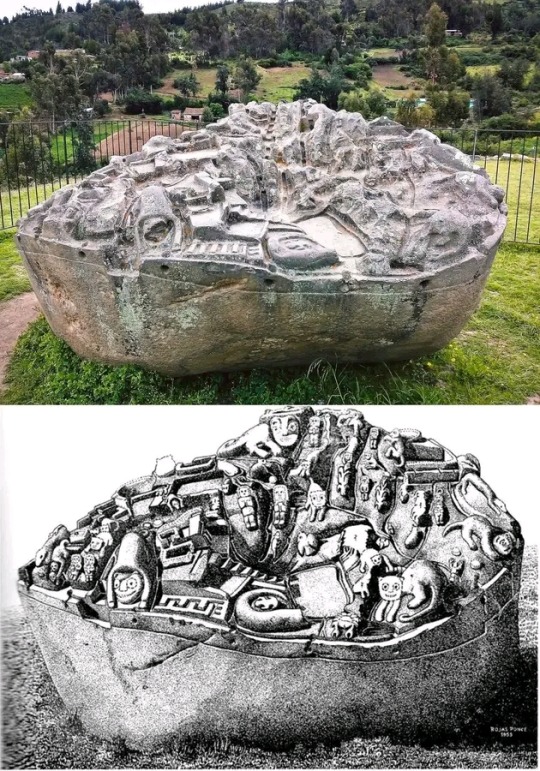
About two meters long, and four meters wide, the mysterious Sayhuite monolith is an enormous rock containing more than 200 geometric and zoomorphic figures, including reptiles, frogs, and felines. Found at the top of a hill named Concacha, the stone was sculpted as a topographical hydraulic model, complete with terraces, ponds, rivers, tunnels, and irrigation channels. The functions or purposes of the stone are not known, but researchers believe the monolith was used as a scale model to design, develop, test, and document the water flow for public water projects, and to teach ancient engineers and technicians the concepts and practices required. The rock was "edited" several times, with new material, either altering the paths of the water or adding routes altogether.
While the creators remain a mystery, the monolith provides archaeologists with insight into the culture of the pre-Columbian population. Archaeologists have determined that the site was an Incan religious center, where rituals and ceremonies for the worship of water was conducted. The monolith is an important clue to this, since it depicts a water-like flow between the carvings. Modern-day engineers also speculate that the monolith is a depiction of the irrigation systems present within the Incan culture.
-John Gotti's Era
21 notes
·
View notes
Text
Me reading about the peopling of the Americas for anthropology: yeah yeah Clovis whatever, pre-Clovis cultures cool cool! Sea and land based routes, ooh, genetic evidences of Polynesian contact! the Siberian-North American language connections, the Incan expedition to Polynesia THE WHAT EXPEDITION TO WHAT NOW???????

#LET'S SAY IT WAS NOT POLYNESIA. ALRIGHT.#WHY AM I JUST LEARNING THAT THERE WERE INCAN OCEANIC EXPEDITIONS#REGISTERED IN SPANISH CHRONICLES NO LESS#cosas mias#history#inca
72 notes
·
View notes
Text
23 notes
·
View notes
Text
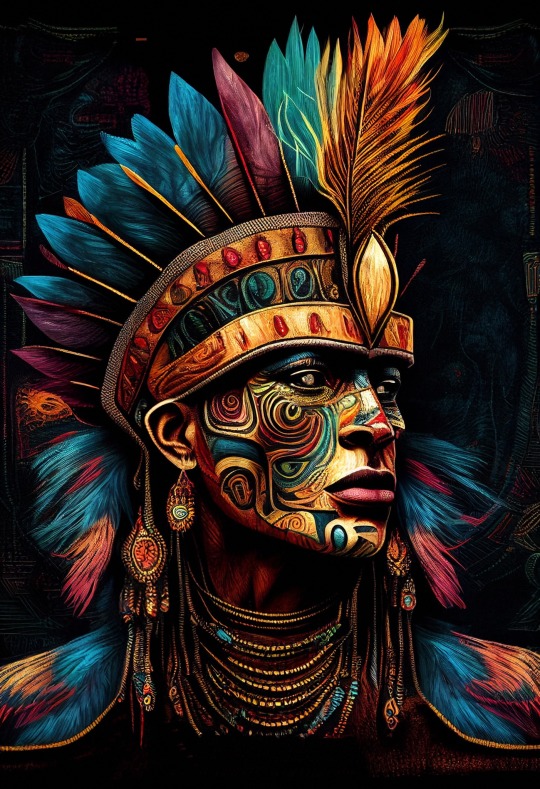
Viracocha: The Great Creator God of the Incas Talon abraxas
THE LEGEND OF VIRACOCHA
Legend tells us that a primordial Viracocha emerged out Lake Titicaca, one of the most beautiful and spiritually bodies of water in the world and located next to Tiwanaku, the epicenter of ancient pre-Hispanic South American culture, believed location of spiritual secrets found in the Andes. Viracocha is intimately connected with the ocean and all water and with the creation of two races of people; a race of giants who were eventually destroyed by their creator, with some being turned into enormous stones believed to still be present at Tiwanaku.
He re-emerged from Lake Titicaca to create the race most associated with humans as we understand them today. Satisfied with his efforts, Viracocha embarked on an odyssey to spread his form of gospel — civilization, from the arts to agriculture, to language, the aspects of humanity that are shared across cultures and beliefs.
While written language was not part of the Incan culture, the rich oral and non-linguistic modes of record-keeping sustained the mythology surrounding Viracocha as the supreme creator of all things. Now much-visited ruins, the distinct structures, and monoliths, including the architecturally stunning Gateway of the Sun, are testimony to the powerful civilization that reached its peak between 500-900 AD, and which deeply influenced the Incan culture.
17 notes
·
View notes
Note
Mochi! You okay with discussing about the economical system the Aztecs and Incas?
I’m really curious what differed from the two.
From what I know from my fathers explanation, the system the Incas had was much better than monarchy because it wasn’t the top that saying “give this quantity” but more like “what can you give?”
And also because the Incas were more or less isolated, they didn’t really exchange goods with other cultures, there was no real market for the outside so they didn’t stocked up beyond themselves. But hey I still need to read more about that.
While I focused on Mesoamerica during school, I focused primarily on culture and social hierarchies (I was very interested in religion), so I don't actually know a lot about either of their economic systems very well.
A quick fun fact, the correct term is actually Inca, it's used as both plural and singular. For the Aztecs, depending on who you ask and what you're specifically referring to, the Aztecs were the Culhua-Mexica or Mexica. Mexica often refers to the people that first established Tenochtitlan, Texcocah and Texcoco, who made up the rules of the entire empire. Typically, this is who most people refer to when talking about "Aztecs," as the term Aztec also might have included the peoples they conquered, though they are using more correct terms in academia now. They were an empire that included other Nahuatl (the language family and people of Southern Mexico and Central America). The term Aztec comes from a myth that the Mexica fled from their original home of Aztlan from the North, though that's a topic for another day, as there's a lot of debate surrounding it. There's a lot more nuance about it, and the issue of all Nahuatl people in Central Mexico being referred to as Mexica by the Spanish. It's the reason Mexico is called such, though the name doesn't reference the other indigenous of Mexico, such as non-Mexica Nahuatl people and the Maya. But that's like a completely different topic.
I do think it's a disservice to call the Inca isolated, as it sort of brushes over the numerous amount of tribes that made up the empire. It was "isolated" in that the Pacific ocean and the Andes mountains didn't allow for easy outside travel, but the empire is made of up a variety of pre-Incan tribes. Some of them were assimilated into the empire, while others were most likely outright destroyed. We have very little traces of pre-Incan people though, so we don't know much about them.
I dug through my old notes and class slides to try and find some stuff, and below gives a good idea of pre-Incan peoples.

I'll have to get back to you on the economy later, as I have to dig through my old stuff to find the info on it.
7 notes
·
View notes
Text
Publications of the New World
The James Smith Noel Collection has closed out another exciting exhibit, this time the topic was the New World of the Americas as experienced by Europe and other explorers. The exhibit: Exploration of the New World features the culture and intriguing history of Central and South America as it was experienced in the resources produced in the 17th, 18th, and 19th centuries. We welcomed visitors to the mysterious, ancient rituals of the Pre-Columbian Mayans, the Aztecs of Mexico, and the Incas of Peru. We also showcased the advancements in architecture, science, and community development while marveling at the natural beauty of the regions.
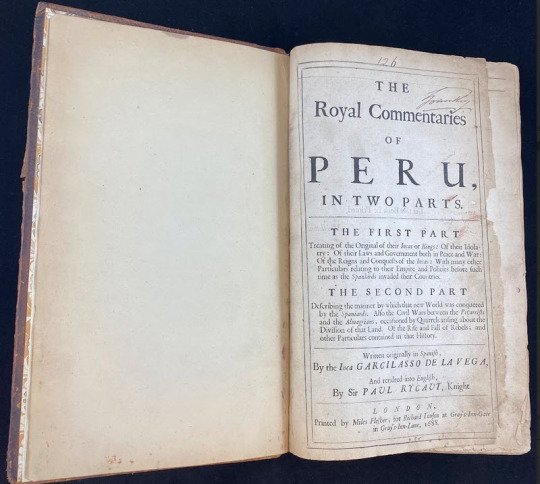
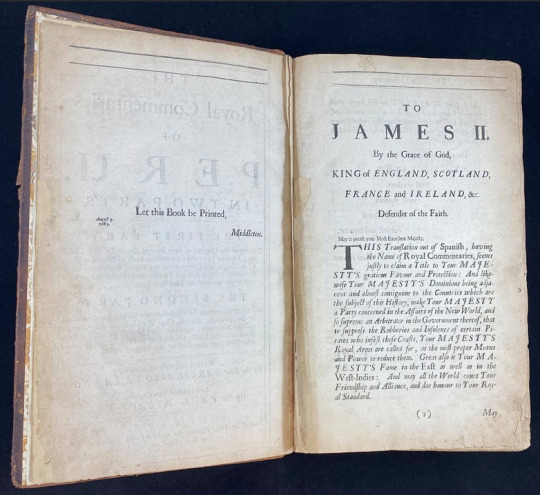
One of the cases displayed a fascinating book which was originally published in Spanish and later translated into English. The edition house in the Noel Collection was published in 1688 of The royal commentaries of Peru, : in two parts. The first part Treating the Original of their Incas or Kings: Of their Idolatry … by Garcilaso de la Vega. Vega wrote a pivotal account of Incan history. Vega has a unique personal connection to the Incan world being a descendant of royal Incan lineage. He was half Spanish and Incan, his father being Spanish, and he chronicled Incan history, culture, and destruction as a result of the Spanish conquest. We featured a portion of text that discussed the minerals, precious metals, and natural resources found in Peru, such as, gold, silver, and mercury or quicksilver.
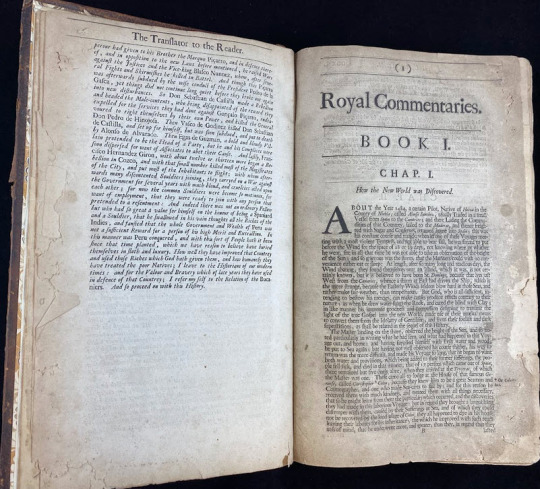
Vega was born as Gómez Suárez de Figueroa in April of 1539, and became known as El Inca. He ventured to Spain when he was 21 where he obtained an informal education and remained until his death in April of 1616. His father died in 1559 and Vega relocated to Spain two years later to seek acknowledgement as the natural son of the Spanish conquistador. His paternal uncle became his protector. While he primarily wrote on the Incan civilization, Spanish conquest, and an account of De Soto’s exploration of Florida.
Gómez Suárez de Figueroa was born in Cuzco, Peru; his father is recorded as being Sabastian Garcilaso de la Vega y Vargas, a Spanish captain, and his mother was Palla Chimpu Ocllo. When his mother was baptized after the fall of Cuzo and renamed Isabel Suarez Chimpu Ocllo, she was descended from Inca nobility, the daughter of Tupac Huallap and granddaughter of Tupac Yupanqui. Vega’s parents were not married in the Catholic church, resulting in his birth being considered illegitimate and he was given his mother’s surname. Vega was a child when his father left and married a younger Spanish noblewoman. His mother married and had two daughters. His first language was Quechua but learned Spanish as a child.
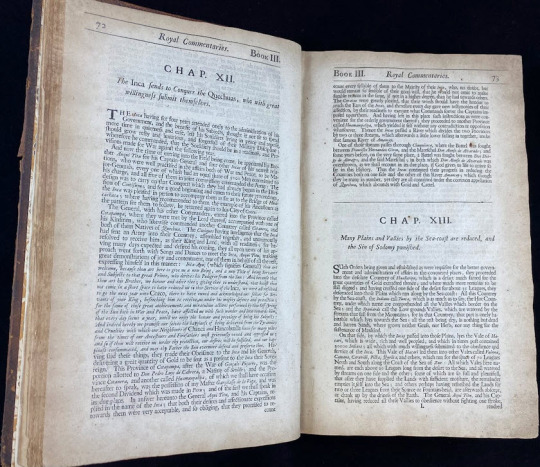

After moving to Spain, he received a European education and the works he produced was considered to have great literary value. He traveled to Montilla and met his father’s brother, Alonso de Vargas, who took him as his protector to help Vega make his way. He traveled to Madrid and petitioned the crown for acknowledgement. He was allowed the name of Garcilaso de la Vega, or "El Inca" or "Inca Garcilaso de la Vega" due to his mixed heritage. He had first-hand experience of the daily-life of the Inca life which heavily influenced his writings. His education allowed him to accurately describe the political system, labor force, and social life of the Incan empire.
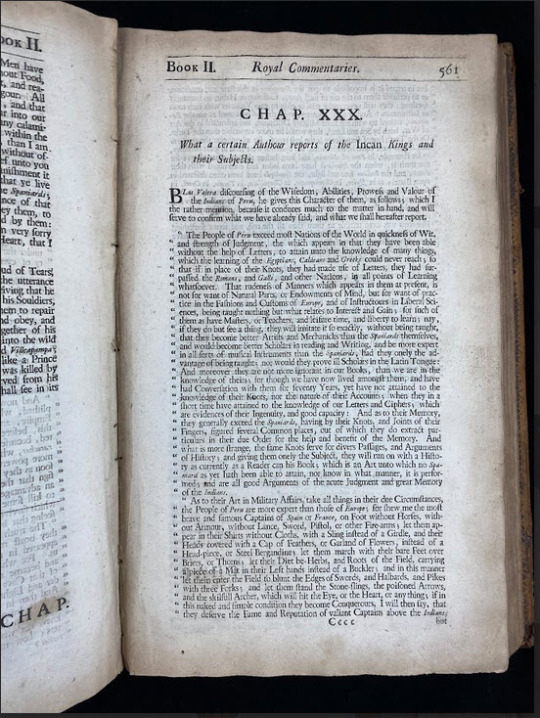
Vega, Garcilaso de la (1688) The royal commentaries of Peru, : in two parts. The first part Treating the Original of their Incas or Kings: Of their Idolatry … London: Printed by Miles Flesher … https://bit.ly/3UxrtdH
Exhibit link: https://bit.ly/3y7k657
9 notes
·
View notes
Text
on indigenous peoples day
lets unlearn the idea that western societies were more civilized and indigenous societies needed instruction.
aztecs had human sacrifices to gods. but spanish people burned people at the stake for their god during the inquisition. incas colonized pre incan peoples. spanish people colonized a whole continent and engaged in chattel slavery. these werent less developed cultures. they were newer cultures. they had techologies the spanish didnt have and the spanish had other tech. the spanish were objectively more barbaric and civilization isn't a cure for barbarism. civilization brings barbarism and order in equal measure.
2 notes
·
View notes
Text

Pre-Incan Site for Ancestor Worship Found in Peru
A team of Peruvian and Japanese archaeologists has unearthed a pre-Hispanic archaeological site in northern Peru dedicated to ancestor worship, with burial chambers, human remains and ceramic offerings.
"We have discovered an archaeological site of the Wari period with an antiquity of between 800 to 1000 years AD" in the Cajamarca region 900 kilometers (560 miles) north of Lima, Japanese archaeologist Shinya Watanabe told AFP on Saturday.
"Two burial chambers with pits for placing mummies and offerings to the ancestors were found at the site," the expert said.
Each of the burial chambers contains two levels, and both have five niches in the walls that contain offerings such as mollusk shells, ceramic fragments and a tripod dish with three conical supports.
"It is a great find because the archaeologists were looking for evidence of the Wari culture," said Watanabe, who is a professor at Nanzan University in Japan.
A bundle containing a female character, a black Wari ceremonial vessel, two musical ceramic wind instruments, and two copper fasteners were also found.
The discovery occurred in the Jequetepeque valley in the province of San Miguel in Cajamarca, a region that abuts Ecuador.

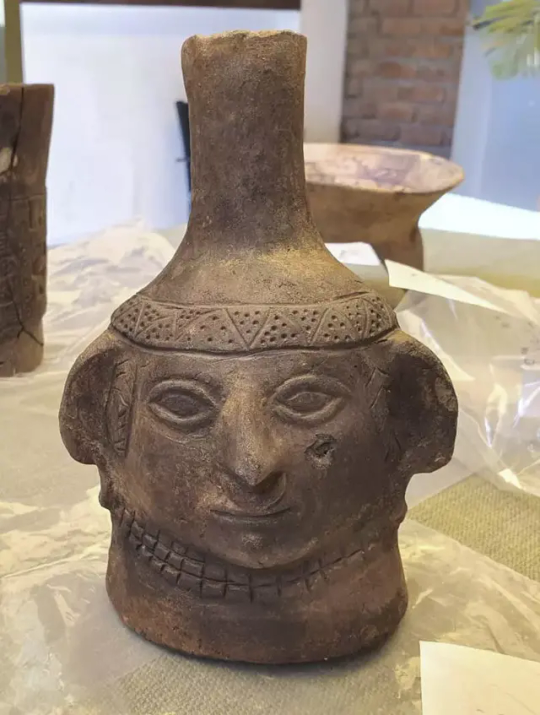
"Many people of multiple origins lived here. It was a ceremonial center dedicated to the cult of the ancestors," Watanabe said.
Judith Padilla, head of Cajamarca's culture office, said the findings allow for an understanding of "the lifestyle and ritual practices" of the ancient societies that inhabited the region.
The Wari culture survived between the 7th and 13th centuries over territory that is present-day Peru, but by 1100 AD the Wari were conquered by the rising Inca empire.
The discovery was made by the Project of Archaeological Investigation (PIA) Terlen-La Bomba and it occupies about 24 hectares (60 acres).
The Ministry of Culture indicated that the main objective of the research is to understand the socio-political system of the Cajamarca culture during the Middle Horizon (900 to 1000 years AD) and its relationship with the Wari culture.
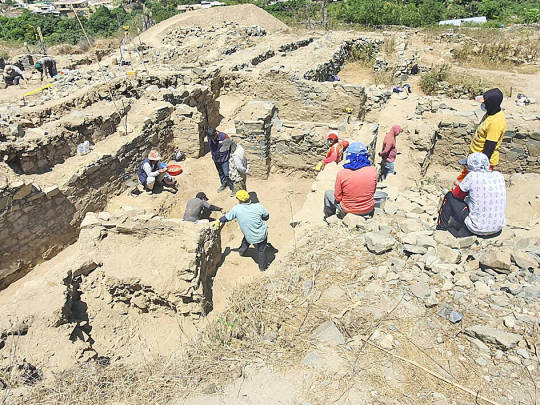

#Pre-Incan Site for Ancestor Worship Found in Peru#Cajamarca region#ancient grave#ancient tomb#ancient artifacts#archeology#archeolgst#history#history news#ancient history#ancient culture#ancient civilizations#wari culture
128 notes
·
View notes
Text
Pure Surrender
Characters: Daniel Miller x Francis Dolarhyde x OC Chasca Flores
Lyn's Writing Event - Week 3 - Day 21
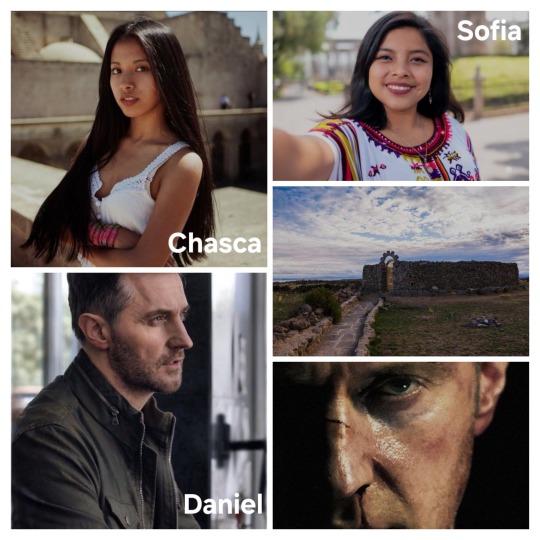
May 21st: Week 3: Incan
Characters: Daniel Miller (AU – Pre S1 BS) x (AU crossover) Francis Dolarhyde x OC Chasca Flores
Fandom; Richard Armitage – Berlin Station/Hannibal – Daniel Miller/ Francis Dolarhyde
The character of Daniel Miller was created by Olen Steinhauer and Francis Dolarhyde was created by Thomas Harris
OC Chasca Flores is created by Kayla Crowe
Word Count: (long one – full story WIP)
Warnings: ritualism, potential smut, virgin sacrifice, trauma, kidnapping, ayahuasca, shamans, human torture, violence (weapons), ancient cultures, nudity, blood rituals.
Daniel lands in Pucallpa, Peru. They house an international airport in that region, and it was the closest landing site to the temple of Pachamama, the Earth Goddess of the Incans. Daniel was assigned to find investigate a series of disappearances of young women. The local authorities were uninterested and Daniel was charged with finding out what was happening to these girls. Daniel was glad to get away from some of the other drama in his life, and took the assignment happily, he just didn’t know he was dealing with a madman.
This is a placeholder because this story is in deep development. You may see some content from it this week, definitely this month.
Lyn's Writing Event 2024
Taglist:
@enchantzz @middleearthpixie @legolasbadass @sweetestgbye
@amylupotter @evenstaredits @lathalea @scariusaquarius
#fanfiction#richard armitage#lyn's writing event 2024#richard armitage x oc#Daniel miller#berlin station#francis dolarhyde#hannibal au#berlin station Au#virgin sacrifice#blood rituals#incans#fertility kink#kidnapping#au crossover#dark content#human torture#trauma
3 notes
·
View notes
Text
In which cultures are emeralds particularly significant?

Because of their captivating green color, emeralds have long piqued the interest of civilizations and are held in high regard in many different cultures worldwide. \
Egypt in the past Emeralds were extremely valuable and regarded as a fertility and rebirth sign in ancient Egypt.
The Aztec and Incan Civilizations In South America's pre-Columbian societies, emeralds were extremely important, especially to the Incas and Aztecs.

Empire of the Mughals Emeralds were prized in India, especially during the Mughal Empire, for their purported therapeutic qualities in addition to their beauty.
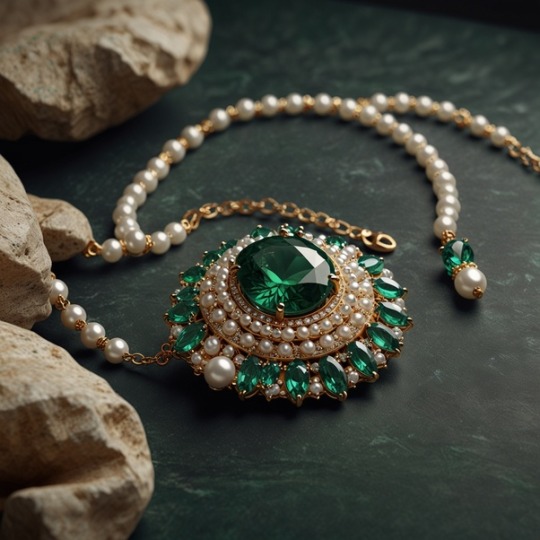
Royalty in Europe For a very long time, European aristocracy has been drawn to emeralds as a symbol of riches, power, and rank.

Contemporary Importance Emeralds are still highly prized in many cultures across the globe today.

#jewelrymaking#3dmodelofjewelry#jewelry#jewelrydesigner#jewelrycaddesigner#jewelry3d#jewerly#jewellery#Custom Jewelry
3 notes
·
View notes
Text
LENIN - "INTIRAYMI"
youtube
Next, from Jessica, a Peruvian house banger with layers...
[7.46]
Jessica Doyle: Don't worry about the backstory yet, there's no rush. Let's start by enjoying a party jam whose ambition shows in its structure: in an era of two-minute songs and dance tracks with no actual rhythm, "Intiraymi" has not only the required bouncy chorus that ends with "ĄEs un carnaval!" but a distinct repeated pre-chorus and a distinct bridge during which to gear up for the final dance. Also, let's face it, this is the best use of strings in a K-pop or K-pop-adjacent song since the legendary "The Ghost of Wind." Even the song's more subtle touches -- that Lenin ends the initial rounds of the chorus on a lower note, so it has more impact when he doubles himself going higher at the end -- work in its favor. Okay, now we can throw in the backstory: Lenin Tamayo Pinares is the son of an Andean folksinger and native speaker of Quecha, and not only a self-produced musician but one committed to using contemporary Andean music as an agent of collective empowerment for indigenous minorities (and hopefully getting an undergraduate thesis done on the topic while he's at it). Fun is fun, and "Intiraymi" is well-crafted, contagious fun no matter how little time you want to invest in it, but you do need a little bit of context to understand why I want this man to realize all of his ambitions and then some. [9]
Nortey Dowuona: "This is not only a positive message," he said of his music. "It's a battle." [10]
Taylor Alatorre: If I were to listen to this without looking any further into Quechua culture, I'd have to guess that the Intiraymi is basically akin to a Copa América celebration. Lenin shows more interest here in creating sounds with cross-border appeal than in putting centuries of suppressed history on display, as is fully his right. Those violin breaks act as tethers to a living past rather than dusted-off artifacts of an ancient one, more evocative of extended family gatherings than Inca and Chanka glories. The sense of forced fun is never entirely absent, but that's something it has in common with family gatherings as well. [6]
Jacob Sujin Kuppermann: Intiraymi is a (Southern Hemisphere) Winter Solstice festival, so it feels appropriate to review "Intiraymi" as I experience the Northern Hemisphere equivalent. This is a banger for the shortest day of the year, a concentrated, poised delivery of hooks that eventually folds into a giddy, delirious fit of ecstasy. [8]
Ian Mathers: Of course, there are only so many combinations of different letters out there; when different languages share the same character sets, you're going to get some weird and/or funny overlaps. Which explains why someone going by Lenin is singing the praises of an Incan festival for the sun god. He's got an interesting background, but I don't have the context to know how significant the subject matter here is. But that's all kind of just background; I don't even need the subtitles to tell that the chorus is celebrating some sort of carnival, and infectiously so. [7]
Joshua Minsoo Kim: An ebullient little house-pop charmer. It's a bit too cheery for my tastes, but those strings are something to celebrate. [5]
Brad Shoup: LENIN's very unsweaty take on K-pop is the draw for sure, but dig that chorus: it sounds like Suede. [7]
Michelle Myers: When you're a K-Pop fan, everything starts to sound like idol music. Tate McRae? She's K-Pop. Ed Sheeran? Totally K-Pop. Nu Metal? That's just Ateez with guitars. But Lenin Tamayo is different. He's purposefully trying to make music that sounds like the Peruvian equivalent of an early 2010s Kenzie banger. [8]
Frank Kogan: This is excitement from the start, the danceable violin riff and the floor beats coming in, a melody with punch and lilt, and on from there: fiddle breaks, sensitive idol star interludes, absolutely sing-a-long-able chorus. His voice is as small as Hilary Duff's, and the wails are more gestured at than actually wailing; so he's getting by on brains more than vocal cords. That's not bad at all, if the arrangements and songwriting get the music to go where he wants it, which they emphatically do here. [7]
Kayla Beardslee: It's so hard to go wrong with a rousing piano-house banger, and this one certainly doesn't! [7]
Aaron Bergstrom: The Inca had a pretty advanced understanding of astronomy. Based on the ruins they left behind, we know they could calculate the solstices with an impressive level of precision. They knew they lived in a clockwork universe, that the days would get shorter until a calculable date, after which they would start to get longer again. And yet, despite this scientific certainty, they still devoutly observed the Inti Raymi, a nine-day festival around the winter solstice dedicated to worshipping the sun god Inti. It's possible there were a few people in those crowds who gave themselves over fully to the supernatural, who worried that they days would keep getting shorter forever unless they properly demonstrated their devotion, but I think most people knew that the sun would return no matter what. That didn't make the Inti Raymi any less important to them. The return of the sun demands celebration, regardless of how your personal cosmology explains it. Anyway, I've been playing this song a lot lately. Today is the shortest day of the year. Tomorrow will be five seconds longer. I'm not saying I caused that, but I'm also not going to stop playing the song. Praise Inti. [9]
Will Adams: How refreshing for a cry of "es un carnaval!" to actually sound like it. How crucial it is for dance-pop bangers to be a little cheesy. [7]
Katherine St Asaph: Power in cheese. [7]
[Read, comment and vote on The Singles Jukebox ]
4 notes
·
View notes
Text

Hey! I know I’ve been posting less frequently, but I wanted to talk to the Genshin Community to question something. (Just a random pic of Fontain for your viewing pleasure)
Where I got the photos!
(I am also not part of any of the affected cultures, but I am bringing this up because we are quite literally near the end of the line.)
Okay, so I want to talk about Natlan and the growing concern I have for the mishmashing cultures we will probs get yet again.
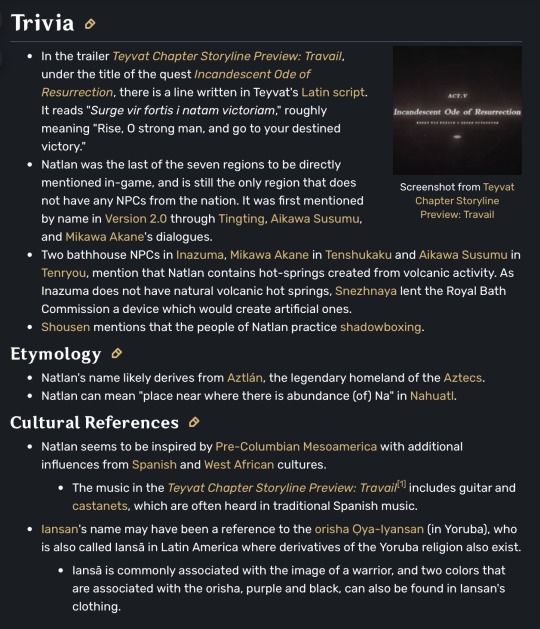
Here, we see that Genshin is trying to tackle both pre-colonial Mezoamerica and ideas of Spanish and West African cultures.
We know an example, Sumeru, where they have gotten backlash from the communities affected, and we know they work their hardest to show the cultural aspects of their stories as best they can with what they are given.
Sadly, this most likely will become like a Sumeru in my eyes, but I am hoping they try to at least make more darker skinned characters in Genshin soon, and give these characters curlier hair. But…
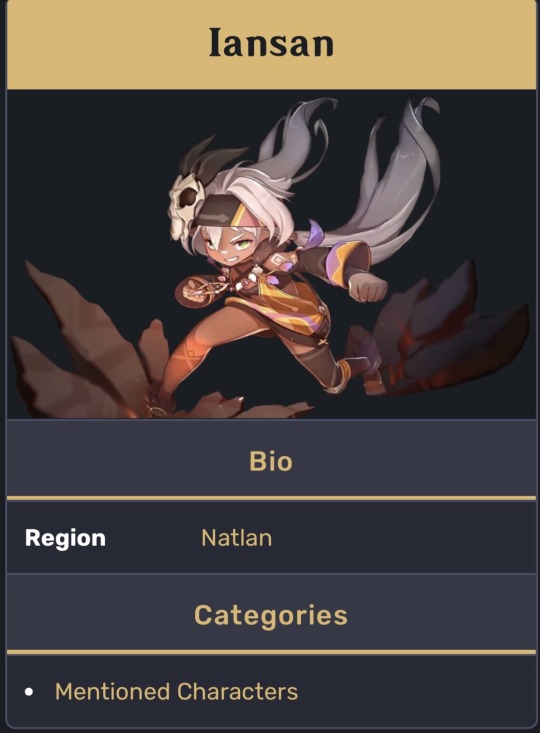
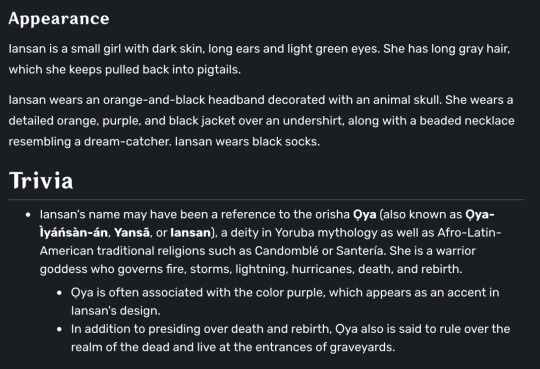
Can’t say I’m hopeful, especially since Murata is hypothesized to be Himeko, and while that is cool for people, It feels weird that a light skinned lady is the leader of a very diverse and dark skinned nation.
Iansan is based of Oya, a Yoruban and Afro-Caribbean Deity. I am not highly studied in the cultural elements, so I will not touch upon them, but I wonder how her character will turn out. But, I would like her to have had a Hydro vision because of the associated element with Iansan’s Deity counterpart.
Next…


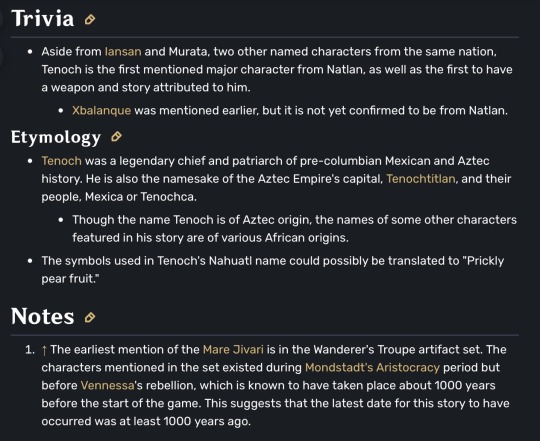
Tenoch is a main lore character of Natlan who had banded all the tribes together. He is based off of a chief of the Aztecs before, also banding together people like Tupac, Wenjiru, and Keyeke. Now, Tupac may make you think of Tupac Shakur the rapper, it is meant to refer to what they would refer to boys in the Incan Empire in Peru! Link.
When I looked up Wenjiru and Keyeke, I got a Kikuyu tale of a lady getting sacrificed and a literally noting aside for hypothetical origination in Nigeria. Ultimately, they most likely will fill this region with lore, but the over mixtures of cultures will cheapen the impact of representation. It’s like your wishing your feet to walk two ways.
Lastly: GENSHIN! GIVE US DARK SKINNED CHARACTERS! ESPECIALLY IN MONDSTADT!!!

This has been a huge issue in my entire time playing Genshin and I cannot stop shutting up about this grave injustice because yes I need people to join my agenda. Where in the hell did the descendents of Venessas’s tribe go? Like, seriously, none of them are even represented in the game, unless I need to look into people’s backgrounds or something but like where is the descendants? Like, did they leave? Where did they go? Mihoyo? WHERE ARE THEY?
As always with these types of persuasive and not really informative content, take this with heaps of salt while researching for answers. Stay safe, stay cool, stay knowing, bye!
5 notes
·
View notes
Text
Maras Salt Mines: A Thousand Pools of Tradition
The Maras Salt Mines, located high in the Sacred Valley, are a stunning testament to ancient ingenuity and sustainable practices. These salt evaporation ponds, carved into the mountainside, have been in use since pre-Inca times and are still operated by local families today.
As you walk among the dazzling white salt pools, you’ll learn how the salt is harvested using traditional methods. The scenic beauty of the surrounding valley only adds to the magic of this destination.
Authentic Incan Adventures includes Maras as part of its Sacred Valley tours, offering a perfect blend of history, culture, and natural wonder. Don’t forget to pick up a bag of the famous pink salt as a souvenir!
0 notes